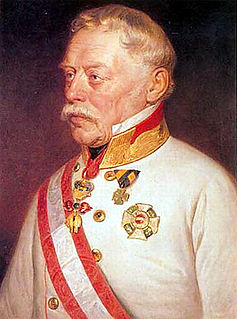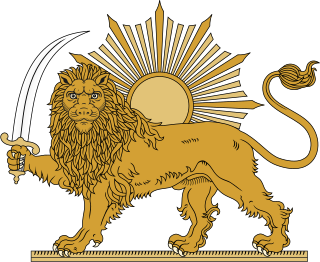
The International Red Cross and Red Crescent Movement is an international humanitarian movement with approximately 17 million volunteers, members and staff worldwide which was founded to protect human life and health, to ensure respect for all human beings, and to prevent and alleviate human suffering.

The flag of Iran is a tricolour comprising equal horizontal bands of green, white and red with the national emblem ("Allah") in red centred on the white band and the takbir written 11 times in the Kufic script in white, at the bottom of the green and the top of the red band.

Grand Cross is the highest class in many orders, and manifested in its insignia. Exceptionally, the highest class may be referred to as Grand Cordon or equivalent. In other cases, the rank of Grand Cross may come after another even higher rank, e.g. Grand Collar. In rare cases, solely the actual insignia is referred to as the "grand cross".

The Order of the Lion of Finland is one of three official orders in Finland, along with the Order of the Cross of Liberty and the Order of the White Rose of Finland. The President of Finland is the Grand Master of all three orders. The orders are administered by boards consisting of a chancellor, a vice-chancellor and at least four members. The orders of the White Rose of Finland and the Lion of Finland have a joint board.

The emblems of the International Red Cross and Red Crescent Movement, under the Geneva Conventions, are to be placed on humanitarian and medical vehicles and buildings, and to be worn by medical personnel and others carrying out humanitarian work, to protect them from military attack on the battlefield. There are four such emblems, three of which are in use: the Red Cross, the Red Crescent, and the Red Crystal. The Red Lion and Sun is also a recognized emblem, but is no longer in use.

Protocol III is a 2005 amendment protocol to the Geneva Conventions relating to the Adoption of an Additional Distinctive Emblem. Under the protocol, the protective sign of the Red Crystal may be displayed by medical and religious personnel at times of war, instead of the traditional Red Cross, or Red Crescent symbols. People displaying any of these protective emblems are performing a humanitarian service and must be protected by all parties to the conflict.

The Coat of arms of New South Wales is the official coat of arms of the Australian state of New South Wales. It was granted by royal warrant of King Edward VII dated 11 October 1906.

The Emblem of Iran since the 1979 Iranian Revolution features the Arabic word Allah ("God"), rendered in stylized characters.
An Islamic flag is a flag either representing an Islamic denomination or religious order, state, civil society, military force or other entity associated with Islam. Islamic flags have a distinct history due to the Islamic prescription on aniconism, making particular colors, inscriptions or symbols such as crescent-and-star popular choices. Since the time of the Islamic prophet Muhammad, flags with certain colors were associated with Islam according to the traditions. Since then, historical Caliphates, modern nation states, certain denominations as well as religious movements have adopted flags to symbolize their Islamic identity.

In heraldry and heraldic vexillology, a blazon is a formal description of a coat of arms, flag or similar emblem, from which the reader can reconstruct the appropriate image. The verb to blazon means to create such a description. The visual depiction of a coat of arms or flag has traditionally had considerable latitude in design, but a verbal blazon specifies the essentially distinctive elements. A coat of arms or flag is therefore primarily defined not by a picture but rather by the wording of its blazon. Blazon also refers to the specialized language in which a blazon is written, and, as a verb, to the act of writing such a description. This language has its own vocabulary, grammar and syntax, which becomes essential for comprehension when blazoning a complex coat of arms.

The Imperial Order of the Lion and the Sun was instituted by Fat’h Ali Shah of the Qajar Dynasty in 1808 to honour foreign officials who had rendered distinguished services to Persia. In 1925, under the Pahlavi dynasty the Order continued as the Order of Homayoun with new insignia, though based on the Lion and Sun motif. This motif was used for centuries by the rulers of Persia, being formally adopted under Mohammad Shah.

The Lion and Sun is one of the main emblems of Iran (Persia), and formerly was an element in Iran's national flag until the 1979 Iranian Revolution. The motif, which illustrates ancient and modern Iranian traditions, became a popular symbol in Iran in the 12th century. The lion and sun symbol is based largely on astronomical and astrological configurations: the ancient sign of the sun in the house of Leo, which itself is traced back to Babylonian astrology and Near Eastern traditions.

The wildlife of Iran include the fauna and flora of Iran.

The Iranian Red Crescent Society (IRCS), officially the Red Crescent Society of the Islamic Republic of Iran is a non-governmental humanitarian organization in Iran. Founded as the Red Lion and Sun Society in 1922, it became affiliated with the International Federation of Red Cross and Red Crescent Societies (IFRC) in 1924 and changed its name and emblem in 1980, informing the international community of Hilal Ahmar adoption while assuming the right to adopt the former emblem in future.

The Order of Zolfaghar is the highest military honour of Iran. |image3 = نشان ذوالفقار در زمان قاجار.jpg |image_size = 400px |caption = The order of Zulfaqar at its foundation in Qajar Era The order was established in 1856 as: The Decoration of the Commander of the Faithful by Emperor Naser al-Din Shah, until 1925 where it was renamed as: The Order of Zolfaghar by Emperor Reza Shah I.

Prince Malek Mansur Mirza (1880–1922) Iranian prince of Qajar dynasty, was Mozaffar al-Din Shah's second son, brother of Mohammad Ali Shah Qajar, Abul-fat'h Mirza Salar-ed-Dowleh and Abul-Fazl Mirza.

Carl Jacob Karsten Petersén was a Swedish Army officer. During World War II he served as head of the intelligence agency C-byrån.

The House Order of Henry the Lion was the House Order of the Duchy of Brunswick. It was instituted by William VIII, Duke of Brunswick on 25 April 1834. The ribbon of the Order was red with yellow edges. It had five grades: Grand Cross, Commander with Sash, Commander, Knight 1st Class, Knight 2nd Class, plus Medal of Merit for Science and Arts, the Cross of Merit and the Medal of Honour.

















